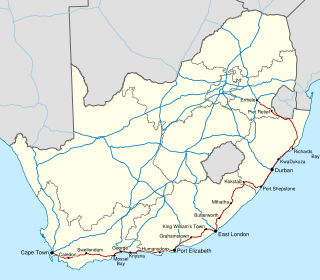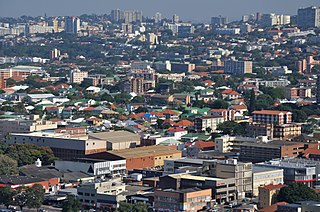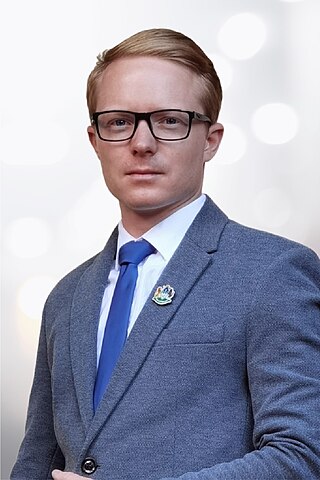
KwaZulu-Natal is a province of South Africa that was created in 1994 when the Zulu bantustan of KwaZulu and Natal Province were merged. It is located in the southeast of the country, with a long shoreline on the Indian Ocean and sharing borders with three other provinces and the countries of Mozambique, Eswatini and Lesotho. Its capital is Pietermaritzburg, and its largest city is Durban. It is the second-most populous province in South Africa, with slightly fewer residents than Gauteng.

Durban, nicknamed Durbs, is the third most populous city in South Africa after Johannesburg and Cape Town and the largest city in KwaZulu-Natal. Durban forms part of the eThekwini Metropolitan Municipality, which includes neighbouring towns and has a population of about 3.44 million, making the combined municipality one of the largest cities on the Indian Ocean coast of the African continent. Durban was also one of the host cities of the 2010 FIFA World Cup.
Pinetown is a large area that is part of the eThekwini Metropolitan Municipality, inland from Durban in KwaZulu-Natal, South Africa. Pinetown is situated 16 km west of Durban at an elevation of 1,000 to 1,300 feet.
Queensburgh is a town in KwaZulu-Natal, South Africa that is situated inland (southwest) from Durban and now forms part of eThekwini, the Greater Durban metropolitan area.
Westville is an area in KwaZulu-Natal, South Africa, and is just west and inland of Durban. It was a formerly independent town however it became part of the eThekwini Metropolitan Municipality in 2002. Westville is situated 10 km inland from the Durban CBD. The climate is subtropical; Westville experiences mild, dry winters, and hot, humid summers with frequent later afternoon downpours.
Inanda or eNanda is a township in KwaZulu-Natal, South Africa that is situated 30 km north-west of the Durban CBD; it forms part of eThekwini, the Greater Durban Metropolitan Municipality. Populated primarily by Zulu-speaking Black Africans, Inanda Township is the home of John Langalibalele Dube, first president of the African National Congress (ANC), as a residence/base of operations of Mahatma Gandhi, and as birthplace of the syncretic Nazareth Baptist Church

Umlazi is a township in KwaZulu-Natal, South Africa, located south-west of Durban. Organisationally and administratively it forms part of the eThekwini Metropolitan Municipality and its South Municipal Planning Region.

The N2 is a national route in South Africa that runs from Cape Town through George, Gqeberha, East London, Mthatha, Port Shepstone and Durban to Ermelo. It is the main highway along the Indian Ocean coast of the country. Its current length of 2,255 kilometres (1,401 mi) makes it the longest numbered route in South Africa.

The University of Natal was a university in the former South African province Natal which later became KwaZulu-Natal. The University of Natal no longer exists as a distinct legal entity, as it was incorporated into the University of KwaZulu-Natal on 1 January 2004. It was founded in 1910 as the Natal University College in Pietermaritzburg and expanded to include a campus in Durban in 1931. In 1947, the university opened a medical school for non-white students in Durban. The Pietermaritzburg campus was known for its agricultural engineering programmes, hence the nickname "the farmers" whilst the Durban campus was known as "the engineers," as it concentrated on other engineering programmes.

Ugu is one of the 11 districts of KwaZulu-Natal province of South Africa. Ugu is Zulu for "coast". It governs the KZN South Coast and its seat is Port Shepstone. The majority of its 722,484 people speak IsiZulu. The district code is DC21.

uMhlanga is a residential, commercial and resort town north of Durban on the coast of KwaZulu-Natal, South Africa. It is part of the eThekwini Metropolitan Municipality, which was created in 2000 and includes the greater Durban area. The name means "place of reeds" in the Zulu language, and the correct pronunciation of "hl" in uMhlanga is similar to the Welsh "ll".

Obed Thembinkosi Mlaba is the former High Commissioner of South Africa to the United Kingdom and served as mayor of Durban, one of the largest and most commercially active cities in South Africa.

Tamil South Africans are Indian South Africans of Tamil descent. Tamil people form the majority of Indian immigrants who came from India to Natal, South Africa, from 1860 onwards. After the expiry of their indentures most of these Indians moved to the cities, becoming established as a thoroughly urban population.

Morningside is a suburb of Durban, KwaZulu-Natal, South Africa.

eThekwini Metropolitan Municipality is a metropolitan municipality created in 2000, that includes the city of Durban, South Africa and surrounding towns. eThekwini is one of the 11 districts of KwaZulu-Natal province of South Africa. The majority of its 3,442,361 people speak Zulu. It was formed from seven formerly independent local councils and tribal land.
The following is a timeline of the history of Pietermaritzburg. It is part of the Msunduzi Local Municipality in the Umgungundlovu District Municipality, KwaZulu-Natal province, South Africa.
Thomas Mxolisi Kaunda is a South African politician from KwaZulu-Natal serving as the Mayor of the eThekwini Metropolitan Municipality since 2019. He was the KwaZulu-Natal MEC for Transport, Community Safety and Liaison from 2016 to 2019 and a member of the KwaZulu-Natal Legislature from 2009 to 2019. Kaunda is a member of the ruling African National Congress (ANC).

Christopher John Pappas is a South African politician who is the mayor of the uMngeni Local Municipality. A member of the Democratic Alliance, he has been the party's deputy provincial leader since 2021. Pappas served as a member of the eThekwini city council from 2016 until 2019 and as a DA Member of the KwaZulu-Natal Legislature from 2019 to 2021.
Vusumuzi Cyril Xaba is a South African politician and a Member of the National Assembly of South Africa since 2019. He is currently serving as Co-Chairperson of the Joint Standing Committee on Defence and as Chairperson of the Portfolio Committee on Defence and Military Veterans. A member of the African National Congress, he previously served in the KwaZulu-Natal Legislature from 1994 to 2009 and from 2014 to 2019. He was the Member of the Executive Council (MEC) for the KwaZulu-Natal Department of Agriculture and Rural Development from 2014 to 2016.
Ntuthuko Mbongiseni Sibiya, known as Jomo Sibiya, is a South African politician who served as the Member of the Executive Council (MEC) for Human Settlements and Public Works in KwaZulu-Natal from March 2021 until August 2022. A member of the African National Congress, Sibiya was elected to the KwaZulu-Natal Legislature in 2014.













